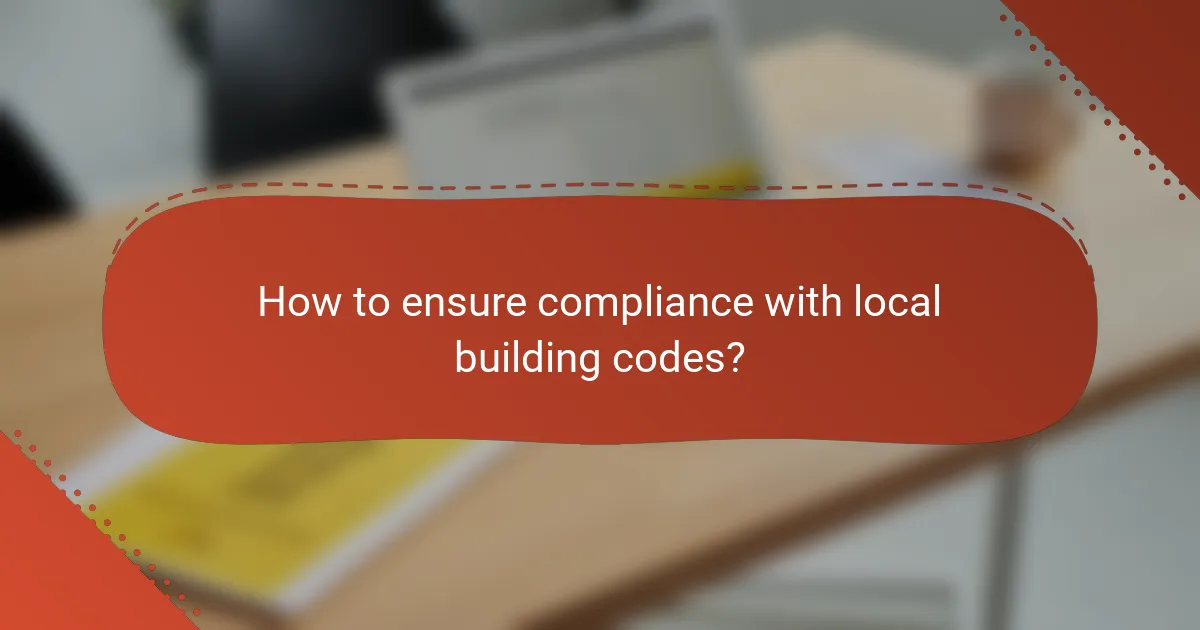Understanding local building codes is vital for anyone involved in construction or renovation projects, as these regulations ensure safety, structural integrity, and accessibility. In Los Angeles, compliance is necessary for obtaining permits and passing inspections, making it essential to familiarize yourself with the specific requirements that apply to your project. Failure to adhere to these codes can result in severe repercussions, including financial penalties and project delays.

What are the key building code requirements in Los Angeles?
The key building code requirements in Los Angeles focus on ensuring safety, structural integrity, and accessibility in both residential and commercial properties. Compliance with these codes is essential for obtaining permits and passing inspections.
Residential building codes
Residential building codes in Los Angeles dictate standards for construction, renovation, and safety in homes. These codes cover aspects such as structural design, fire safety, plumbing, and electrical systems. Homeowners must ensure that their projects adhere to these regulations to avoid penalties and ensure safety.
Key requirements often include minimum ceiling heights, proper egress windows, and specific insulation standards. It’s advisable to consult the Los Angeles Department of Building and Safety for detailed guidelines relevant to specific projects.
Commercial building codes
Commercial building codes in Los Angeles are designed to regulate the construction and occupancy of commercial properties. These codes address issues such as occupancy load, fire protection systems, and accessibility for individuals with disabilities. Compliance is crucial for businesses to operate legally and safely.
For commercial buildings, factors like parking requirements, signage regulations, and energy efficiency standards are also included. Engaging with a licensed architect or contractor familiar with local codes can streamline the compliance process.
Safety regulations
Safety regulations in Los Angeles encompass a range of requirements aimed at protecting occupants and the public. These include fire safety measures, structural integrity mandates, and emergency egress provisions. Regular inspections are often required to ensure ongoing compliance.
Building owners should implement safety features such as smoke detectors, fire alarms, and sprinkler systems, which are often mandated by local codes. Familiarizing oneself with the California Building Code can provide additional insights into safety requirements.
Accessibility standards
Accessibility standards in Los Angeles ensure that buildings are usable by individuals with disabilities. These standards are aligned with the Americans with Disabilities Act (ADA) and local regulations, requiring features like ramps, accessible restrooms, and designated parking spaces.
When designing or renovating a building, it is essential to incorporate these accessibility features from the outset. Failure to comply can result in legal challenges and costly modifications later. Consulting with accessibility experts can help ensure that all necessary standards are met effectively.

How to ensure compliance with local building codes?
To ensure compliance with local building codes, it is essential to understand the specific regulations that apply to your project and follow them closely. This involves obtaining the necessary permits, hiring qualified professionals, and conducting regular inspections throughout the construction process.
Obtain necessary permits
Before commencing any construction, securing the appropriate permits is crucial. These permits vary by locality and may include building, electrical, plumbing, and zoning permits. Check with your local building department to determine which permits are required for your specific project.
Failure to obtain the necessary permits can lead to fines, project delays, or even the requirement to dismantle completed work. Always keep copies of your permits on-site to avoid complications during inspections.
Hire licensed contractors
Hiring licensed contractors is vital for ensuring that your project adheres to local building codes. Licensed professionals have the training and knowledge to navigate complex regulations and can help prevent costly mistakes. Verify that your contractor holds the appropriate licenses and insurance for your area.
Consider checking references and past work to ensure the contractor has experience with similar projects. This can provide peace of mind and help you avoid potential compliance issues down the line.
Conduct regular inspections
Regular inspections are essential to ensure ongoing compliance with local building codes throughout the construction process. Schedule inspections at key milestones, such as after foundation work, framing, and before final finishes. This allows for timely identification of any issues that may arise.
Be proactive in addressing any code violations that inspectors may point out. This not only helps avoid penalties but also ensures the safety and integrity of your building project. Keep detailed records of all inspections and any corrective actions taken for future reference.

What are the consequences of non-compliance in California?
Non-compliance with building codes in California can lead to significant repercussions, including financial penalties, legal actions, and project delays. Understanding these consequences is crucial for anyone involved in construction or renovation projects.
Fines and penalties
In California, fines for non-compliance can vary widely based on the severity of the violation. Minor infractions might incur fines in the low hundreds of dollars, while more serious breaches can lead to penalties in the thousands. Additionally, repeated violations may result in escalating fines.
It’s essential to stay updated on local regulations, as municipalities may impose their own specific fines and penalties. Regularly consulting with local building authorities can help avoid unexpected costs.
Legal action
Failure to comply with building codes can expose individuals and companies to legal action. This may include lawsuits from affected parties, such as neighbors or clients, seeking damages for non-compliance. Legal fees can accumulate quickly, adding to the overall cost of non-compliance.
In some cases, local governments may also pursue legal action to enforce compliance, which can lead to court orders requiring remedial work or even halting construction projects until issues are resolved.
Project delays
Non-compliance often results in project delays, as authorities may require additional inspections or modifications before work can continue. These delays can extend timelines significantly, sometimes by weeks or months, depending on the nature of the violations.
To mitigate delays, it’s advisable to conduct thorough pre-construction reviews and ensure all plans meet local codes before starting work. Engaging with experienced contractors familiar with local regulations can also help streamline the process.

How to stay updated on building code changes?
To stay updated on building code changes, regularly check official sources and engage with industry professionals. This ensures you are aware of the latest regulations and compliance requirements that may affect your projects.
Follow local government websites
Local government websites are primary sources for building code updates. They often publish new regulations, amendments, and guidelines that impact construction practices in your area. Bookmark these sites for quick access and set alerts if available.
Check for sections dedicated to building permits and codes, as they typically provide downloadable documents and detailed explanations of any changes. Regular visits can help you stay informed about deadlines and compliance requirements.
Subscribe to industry newsletters
Subscribing to industry newsletters is an effective way to receive timely updates on building codes. Many organizations and trade associations offer newsletters that summarize changes and highlight important information relevant to builders and contractors.
Look for newsletters that focus on your specific region or sector, as they often include insights from local experts and case studies that illustrate how changes are being implemented. This can provide practical context for understanding new regulations.
Attend local building department meetings
Attending local building department meetings allows you to hear directly from officials about upcoming code changes. These meetings often include discussions on proposed regulations and provide an opportunity for public feedback, making them valuable for staying engaged.
Check the schedule for these meetings on your local government website and consider participating regularly. Networking with other professionals at these events can also lead to valuable insights and shared experiences regarding compliance challenges.

What resources are available for understanding building codes?
Understanding building codes is essential for compliance and safety in construction projects. Various resources are available, including government agencies, local departments, and professional organizations that provide guidance and updates on building standards.
California Building Standards Commission
The California Building Standards Commission (CBSC) oversees the development and implementation of building codes across the state. They publish the California Building Code, which outlines the minimum safety standards for construction and renovation projects.
To stay updated, visit the CBSC website regularly for announcements, code updates, and access to training materials. Engaging with their resources can help ensure compliance with state regulations and avoid potential legal issues.
Local building department resources
Your local building department is a crucial resource for understanding specific building codes applicable to your area. They provide information on permits, inspections, and local amendments to state codes that may affect your project.
Contact your local department directly or visit their website for resources such as code handbooks, application forms, and FAQs. Familiarizing yourself with these materials can streamline the permitting process and ensure your project meets all local requirements.
Professional associations
Professional associations, such as the American Institute of Architects (AIA) and the National Association of Home Builders (NAHB), offer valuable resources for understanding building codes. These organizations provide educational materials, workshops, and networking opportunities that can enhance your knowledge of compliance requirements.
Joining a professional association can also connect you with experts in the field who can offer insights into best practices and recent changes in building codes. Take advantage of their resources to stay informed and compliant in your construction endeavors.

What are the emerging trends in building codes?
Emerging trends in building codes focus on sustainability, energy efficiency, and resilience against climate change. These trends reflect a growing emphasis on reducing environmental impact and enhancing the safety and durability of structures.
Increased focus on sustainability
Building codes are increasingly incorporating sustainability measures, such as mandates for energy-efficient materials and renewable energy sources. This shift encourages builders to adopt practices that minimize waste and reduce carbon footprints.
For example, many jurisdictions now require the use of sustainable materials like bamboo or recycled steel. Additionally, energy-efficient systems, such as solar panels and high-performance insulation, are becoming standard in new constructions.
Integration of smart technology
Smart technology integration is becoming a key component of modern building codes. This includes requirements for systems that enhance energy management, security, and occupant comfort through automation and connectivity.
For instance, codes may now mandate the installation of smart thermostats or energy monitoring systems that allow for real-time adjustments and optimizations. Such technologies not only improve efficiency but also provide valuable data for ongoing maintenance and performance assessments.
Resilience against climate change
As climate change poses increasing risks, building codes are evolving to enhance resilience against extreme weather events. This includes stricter requirements for flood-resistant construction and wind-resistant designs in vulnerable areas.
For example, coastal regions may enforce codes that require elevated foundations and reinforced structures to withstand hurricanes. Builders should stay informed about local regulations that address these challenges to ensure compliance and safety.
